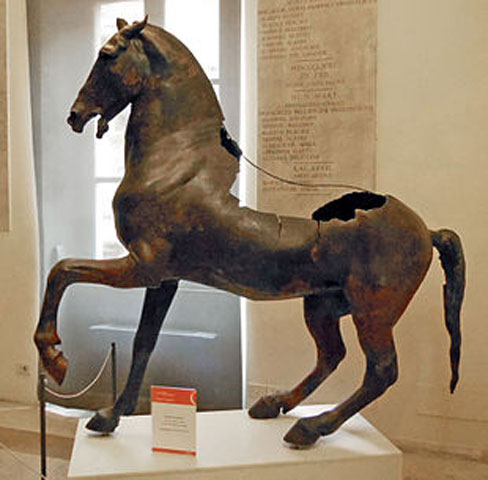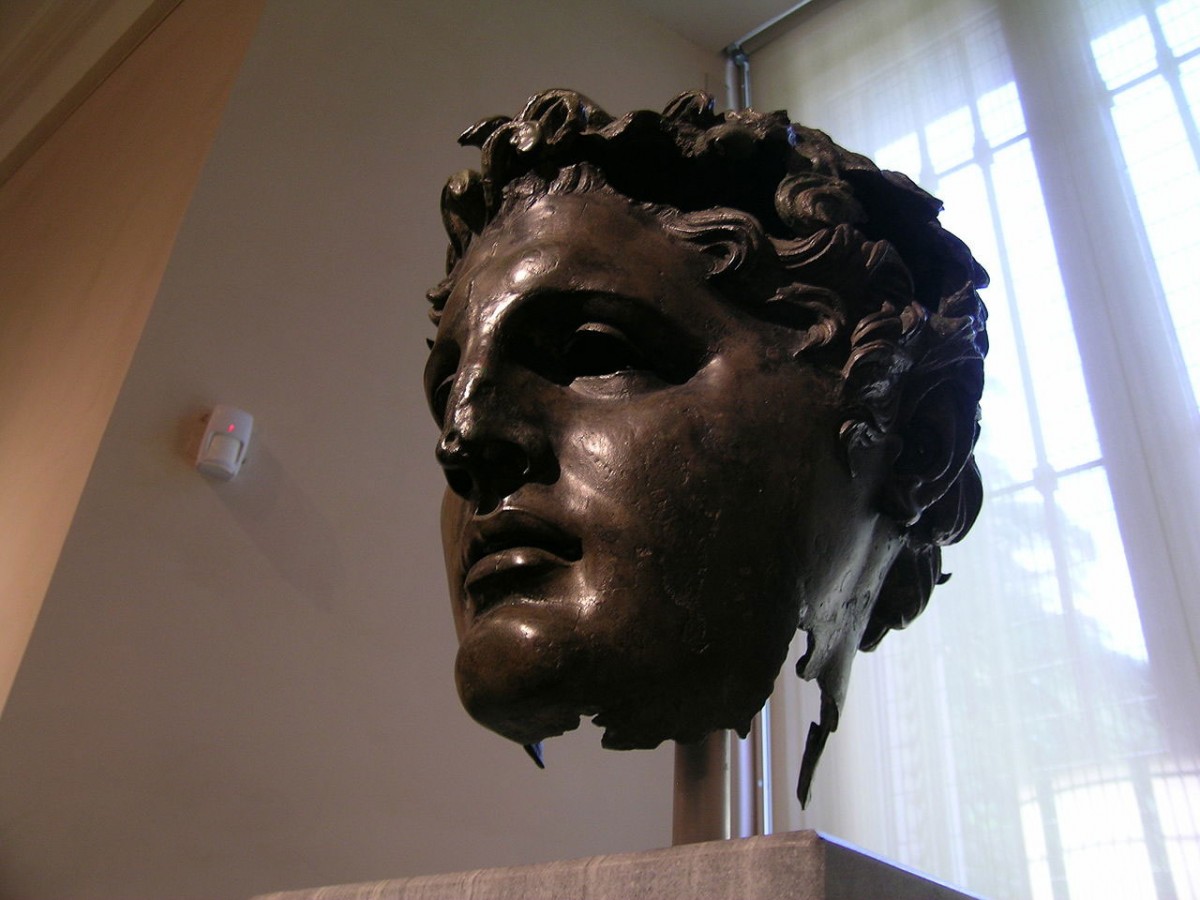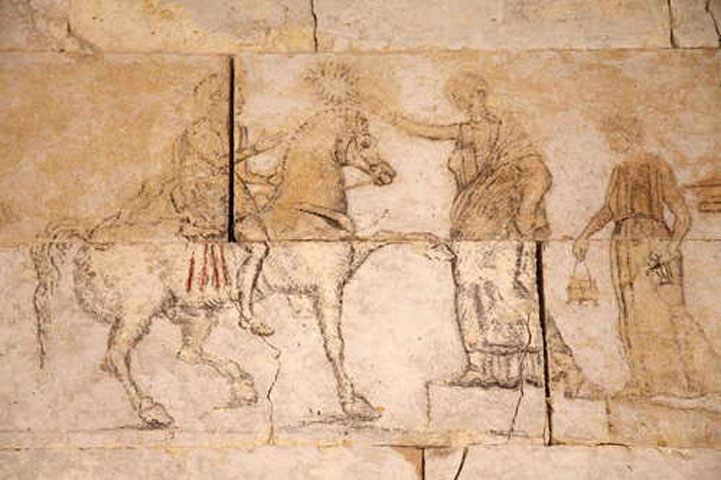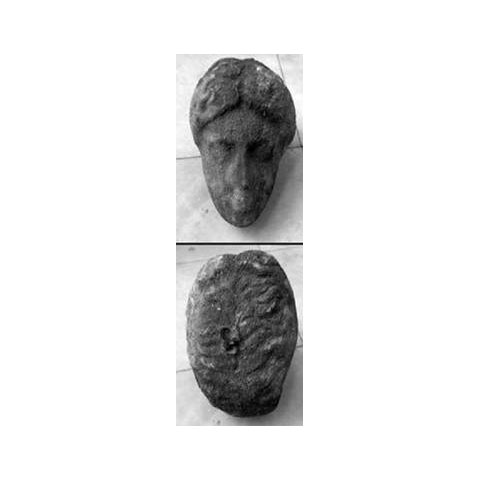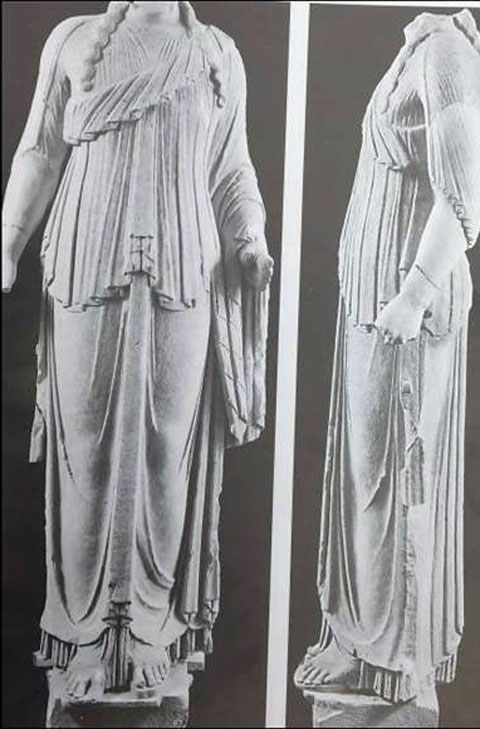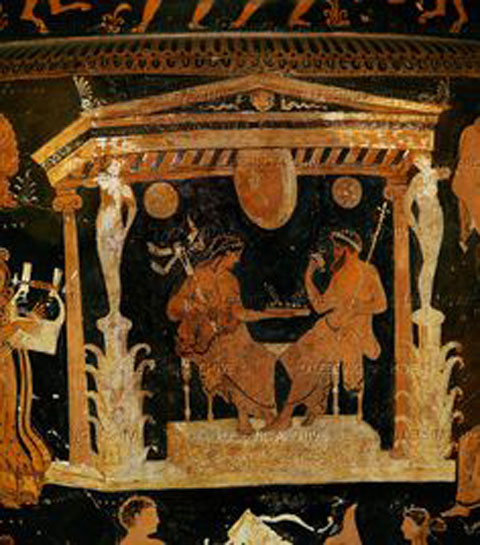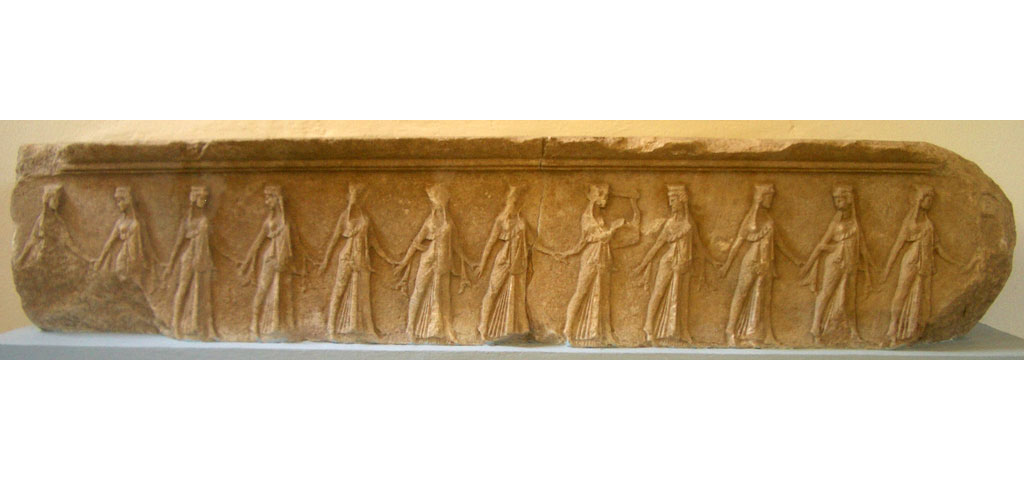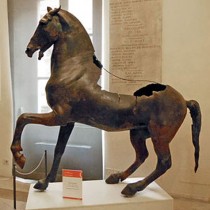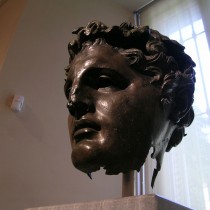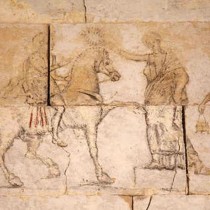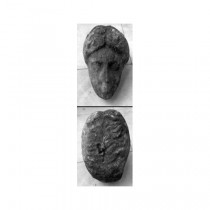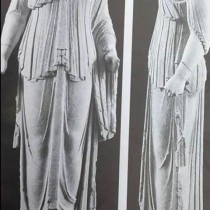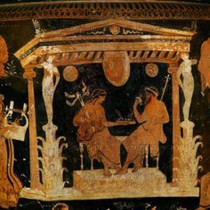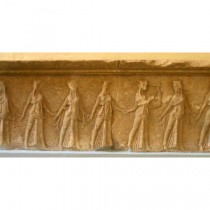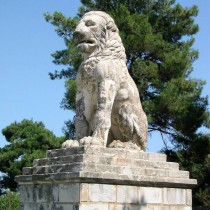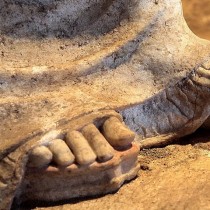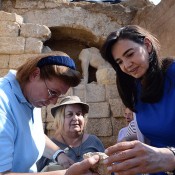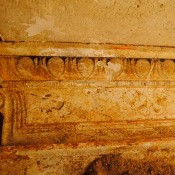In Part 1 of the Tumulus Kasta account the monument was presented and then there was a detailed description and interpretation of the lion of Amphipolis, the relief frieze and the first room. In this part of the article, the second, third and fourth room will be examined and general conclusions will be drawn.
e. The second room
Beyond the entrance described in Part 1, chapter d, of this article, there is Room 2: a rectangular space covered by barrel vault roof, which was largely used in Macedon in the late 4th c. BC (note 1).
The stone chips pavement of Room 2 has in the middle a rectangle which is framed by four lines of chips: probably it was the place for the base of a statue. Since epigraphic evidence refers to the monument as the “heroon of Hephaestion”, it is probably here that the bronze monument of Hephaestion conceived by Lysippus (note 2) and constructed by Philon (note 3) stood.
Since Tatian saw this statue in Rome, the masterpiece was removed from Amphipolis―probably when the town, having sided with Mithridates, fell to Sulla and thus was brought to Rome in the occasion of the huge triumph of this Roman general (note 4).
There are two surviving elements of a bronze equestrian statue from Rome which probably were part of the monument of Hephaestion made by Lysippus and Philon:
- a bronze horse found in Rome and kept there, in the Capitoline Museums (no. 1064), whose Lysippan pedigree has been established (note 5, fig. 1);
- a bronze head once in the Farnese Collection, then in the Collection of king Philip V of Spain, in San Ildefonso, Palacio Real, now at Madrid, Prado (no. 99 E) (note 6), which has been recognized as the portrait of Hephaestion (note 7, fig. 2).
A general idea of this equestrian monument may be offered by the painted representation of a young knight on a horse in the royal tomb of Sveshtari of the early 3rd c. BC, which displays female architectural supports also derived from those of the tumulus Kasta. The horse with the knight is represented in the semicircular section of a short side of the burial room of the tomb of Sveshtari, above the Caryatids and bears both position and shape of the bronze horse in the Capitoline Museums (note 8, fig. 3). Probably the tumulus Kasta was very renowned and thus picking up patterns of this monument was regarded a dignifying practice by the Thracian elites.
The necessity to make space to this equestrian monument would justify the noteworthy size of Room 2.
A foot of the knight on the Capitoline horse survives: he wore trochades boots which were in use also in the entourage of the hetairoi of Alexander (note 9). The ratio of the foot length to the height of the head of Madrid is 2:3. This fact suggests that head and foot pertained to the same bronze body. Moreover, the bronze head at Madrid has been conceived for profile views. In fact the head when seen in full prospect reveals a clear asymmetry which existed even before the damage suffered by this sculpture. The contrast between this shortcoming in its front view and the extremely high quality of the same head in its profile views may be explained by the suggestion that the prospect of the head was partly shielded by the head of the horse and that thus the sculptor knew that the head was going to be seen mostly from the sides.
The boot on the surviving bronze foot bears decorations of acanthus which may reveal both the pertinence of the monument to the Delphic realm and the heroic/funerary nature of the monument.
As Parisi Presicce notes (note 10), “in antiquity, in order to avoid that the animal is more imposing than the human figure, the proportions of the knight are usually a little larger than those of the horse”. In the case of over-life-sized figures, the head, not being close to the viewer and thus looking small because of its distance, had to be enlarged with the so-called optical correction.
The passage from Room 2 to Room 3 is made by a succession, from below, of two pseudo-isodomic bases supporting two pillars above which there is an architrave with three fasciae. The semicircular space between the architrave and the barrel vault is closed with pseudo-isodomic masonry.
In front of the two pillars, two female architectural supports are represented: they are statues in Thasian marble of young girls (korai) with poloi, girdles below the breasts, and long legs. Only the face of one of these two girls is preserved. They wear chiton and himation. With their external arm they hold the drapery while the other arm, of which one hand is preserved, was outstretched, probably in order to carry a wreath and to award the knight who was in front of them. A tall girl is depicted offering the knight a wreath also in the above mentioned representation of Sveshtari.
Their draperies bear, in the area of the belly, a triangular pattern with borders decorated with zigzag patterns. The strap of the mantel is stretched across the chest and decorated with oblique lines. The feet on the internal side are slightly in front of those on the external side. They wear indented sandals.
The surviving face bears a strong similarity to a female head from the Herakleion of Thasos (note 11, fig. 4). This fact suggests that the workshop responsible for these korai was a Thasian one, perhaps the same or one near to that which delivered the head from the Thasian Herakleion.
The peculiar rendering of the drapery of these Korai with the triangular pattern with zigzag borders on the belly and the strap with oblique lines can be found also in a statue of Dionysos from the late 4th c. phase of the theatre of Euonymos (note 12, fig. 5). This statue was dedicated by Olympiodoros son of Diotimos, who is known to have been active in Athenian politics in the 330s and 320s BC (note 13).
Girdles below breasts are ubiquitous in Greek imagery after 340 BC (note 14) as well as indented sandals (note 15).
Moreover slender girls with long legs, holding their drapery with one hand and outstretching the other, used as architectural supports, appear in front of the columned propylon to the palace of Persephone and Hades in a vase painting dated around 340-320 BC and representing the underworld according to the Orphic mysteries (Orpheus is playing his cithara near that palace) (note 16, fig. 6).
The slender proportions of the girls appear indebted to the Lysippan kanon of the human body.
Concerning the function of these architectural females, the korai with similar schema in the above mentioned vase painting suggest an Orphic interpretation: with their beauty, youth, smiling face and dancing attitude, they welcome the “worthy” visitor into the space where contact with the underworld is possible.
More specifically, comparison with the relief frieze of choral dancers in the Hall of Choral Dancers on Samothrace is enlightening (note 17, fig. 7): even these Najad Nymphs wear poloi, belts decorated with oblique lines across their chests and their chitons and himatia determine triangular patterns with borders decorated with zigzag folds. The close relation of the Najads of the great mysteries of Samothrace with the Korai of the tumulus Kasta leads to the possibility that the Korai of Kasta are also Najads of the Samothracian cult and that exactly in the position where they are they welcome the initiated to the great mysteries.
Needless to say, the late classical date of the Najads of the Choral Dancers Hall confirms ad abundantiam the late classical date also of the Korai of Amphipolis.
Finally, since it is well known that Olympiad, Alexander’s mother, was endowed with a religious capacity in the sanctuary of the great gods of Samothrace (note 18), the connection of the dancers of Samothrace with the female architectural supports of Amphipolis suggests that Olympiad may have been among the patrons if not the main patron of the architectural enterprise of the tumulus Kasta.
f. The third room
Beyond the Korai, there is Room 3.
The pavement of this room is a pebble mosaic featuring the kidnapping of Persephone by Hades.
The general schema of this mosaic is similar to the painting with the same subject at Vergina (note 19). The similarity between these two representations of the same episode is probably to be explained by the circumstance that both mosaic and painting are inspired by the picture with the kidnapping of Persephone made by the renowned painter Nikomachos (Pliny 35.108) who worked for the Macedonian royalty (note 20).
The presence of this sacred representation probably makes it clear that Room 3 is the sancta sanctorum of this complex, the very place where something very important took place.
A circular hole in the middle of the mosaic perhaps is due to the setting of a circular altar or of a tripod.
The cornice of Room 3 was painted on the north side―i.e. toward Room 4 or toward the burial chamber, above the marble door, as well as on the short east and west sides.
The paintings on the west cornice do not survive.
The north side from the viewer’s left to right displays first of all a human with his head looking straight ahead, toward the rest of the frieze: his arms are also outstretched. He may hold a stick in his left hand. Comparison with the seer who with a similar position sees the race between Pelops and Oenomaus in the east pediment of the temple of Zeus at Olympia (note 21) leads to the suggestion that this is a seer who sees all the oracular happenings which are displayed in the following part of the north frieze. Who this seer is will be clarified below.
After this man, we have a probable Sphinx above a column, a garlanded bull between two Centaurs who are pouring wine to the bull. At both sides of the Centaurs there are vases which probably contained the liquids which are about to be poured by the Centaurs.
Two interpretations are possible:
- The bull is Dionysos Tauros (note 22), the Centaurs would be represented because of their proverbial love for wine (note 23) which makes them timely presences in the retinue of the god of wine. The Sphinx was also regarded close to Dionysos (note 24).
- The garlanded bull is the king of Macedon Philip II, defined such in an oracle of the Pythia who predicted his imminent death (note 25), the Centaurs may represent the homage of Thessaly to the king who subdued it, while the Sphinx above the column may represent the Sphinx of the Naxians at Delphi (note 26),thus making clear the place where the prophecy was uttered.
Alternatively, the Sphinx may be here a death daemon: this is a well known function of this daemon (note 27).
Centaurs were represented also on the pyre of Hephaestion (Diodorus 17.115), where they expressed the heroic identity of the deceased: thus the Centaurs in the painted frieze may also reveal the mixed nature which by now characterized Hephaestion as a semi-god.
The general schema of the human, frontal parts of the Centaurs derives from that of Praxiteles’ Pouring Satyr (note 28): this fact reveals the appeal of famous opera nobilia on patrons and artists charged of the tumulus Kasta and in particular the importance of the Praxitelean formal heritage in the imagery of the late 4th c. BC.
After this episode, two winged females are disposed in heraldic diagonal position at the sides of a tripod: they may be Nikai and represent the victory upon Persia which was also due to oracles uttered at Delphi upon request from Alexander (note 29) and symbolized by the tripod. Both Nikai appear to be on prows of boats and thus they announce victory in an overseas expedition: the Nike on the prow of a boat on a coin type struck by Demetrios Poliorketes in the late 4th c. BC may be suggested for a close comparison (note 30).
Prows of boats also appeared on the pyre of Hephaestion (Diodorus 17.115), which was clearly a source of inspiration for both patron and painter of the frieze.
The tripod between the Nikai rests on a red purple fabric. Fabrics of this colour had been exposed also on the pyre of Hephaestion (Diodorus 17.115) and of course advertised the royal patronage of the monument.
After the two Nikai with the tripod, a sea horse emerges from the sea with the upper section of its body: probably it marks that we are still on the water. It derives from the sea thiasoi which, after a famous creation by Skopas (Pliny 36.25-26) were very trendy in the 4th c. BC (note 31).
This scene is followed by another which unfortunately is not well preserved but seems to represent a boat supporting a tripod.
Probably it epitomizes the expedition of Alexander in its making and expresses the concept that its victory delivers the prediction of Delphic Apollo.
After the boat, there is a scene depicting a soldier with helmet on a horse followed by a charioteer on his chariot. Probably this is the representation of the ekphora of the body of Hephaestion from Babylon, which will be symbolized by an emblematic monument in the next scene, to Amphipolis. A tree may be represented between the horse and the charioteer.
The charioteer is bent forward: this feature is typical of charioteers in the visual culture of Macedon in late classical times (note 32). Before this period, in early and middle classical times, charioteers were represented with upright positions (note 33) and will be again endowed with erected torsos in late Hellenistic times (note 34).
Behind the chariot, a large pathetic head is represented: with long hair, deep eyes-sockets, high forehead and beard. As a similar head which appears in the next scene, this head may represent Zeus, who decides everything which happens in the world. As in the east pediment of the temple of Zeus at Olympia, his presence is not seen by the persons of the episodes represented but is behind any moment of the glorious story which is shown in this frieze.
Below the charioteer, there are waves which of course refer to the sea and there is an object which has the shape of an omphalos, perhaps again on a purple red fabric: it conveys the message that everything represented in the frieze is accomplished according to predictions of Delphic Apollo.
After the omphalos there is a high slightly tapering building which seems followed by a panoplia above which an eagle is flying toward a standing man with the kausia hat. Of course the man with the kausia is Κing Alexander (note 35), the eagle flying toward him reveals that he is the son of Zeus, probably he is accomplishing the sacrifice on the panoplia in front of the pyre of Hephaestion, which would be the tall tapering building. Thus we have here the farewell ceremony by Alexander to Hephaestion (note 36). According to Diodorus 17.115, the pyre of Hephaestion had a square base and looked like a tall tower. It had prows of boats at its base and a prow is detected at the viewer’s left of the tower. This observation strengthens the identification of the tower as the pyre of Hephaestion. Moreover, the upper part of the pyre was endowed with representations of eagles ready to flight. Thus the eagle represented between the tower and Alexander may refer to this decoration. Of course eagles also announce the heroic and divine status of the deceased.
According to Aelian, Varia Historia 7.8) a panoplia was thrown on the pyre of Hephaestion. Moreover, another panoplia was represented on the pyre, as it argued by Diodorus 17.115: thus Alexander is represented while he is acting at the ceremony in front of the panoplia thrown on the pyre.
The slender proportions of Alexander are in keeping with the Lysippan kanon.
Behind the eagle a face appears: it is much larger than other faces on the frieze, it has pathetic eyes and a large, semicircular beard: of course he is Zeus who sent the eagle toward Alexander, in order to underline his protection upon his son.
The pyramid which follows probably refers to another important oracular statement: that of the oracle of Zeus Amon at Siwa which imposed the institution of sacrifices to god Hephaestion (note 37).
After this episode there is a procession of knights, probably attending the funerary honors to Hephaestion, the representation of one of them with a kausia suggests that Alexander was also portrayed in this section of the frieze. Knights were an obvious presence in triumphal friezes from the time of the Parthenon frieze.
In the east side, the cornice shows probably the funerary kline, which is so important in Macedonian official imagery (note 38): probably we have here the prothesis of Hephaestion on his kline. Then a theory of dignitaries attends the prothesis. A round shield is visible and suggests that the represented dignitaries are high ranking officials of the Macedonian army (Hetairoi?). The recognition of the figure of a tropaion among these standing figures strengthens the impression that here we have a martial, military attendance to the prothesis of the deceased.
Then there are two winged females (Nikai?) carrying a tripod above a semicircular red purple fabric which may be a Macedonian chlamys in profile view: this scene announces the divinization of the hero.
Then there is an assembly of gods who welcome the new god: this divine series includes a Rhea represented frontally with the same iconography of the Meter of Agorakritos (note 39). Rhea was a very important figure in the Orphic mysteries: in the shape of a snake she had sex with Zeus who also had a similar metamorphosis, and she generated Persephone (note 40).
Macedoniam pezetairoi, one displaying his round shield with episema, are standing at the end of the figures of gods: they convey the notion that the achievements of the honoured hero were in service of the Macedonian state.
Then there is a frieze of weapons, of which a helmet is clearly preserved and which gives the information that the hero took part to important military campaigns: friezes of weapons were also typical in Macedonian official imagery (note 41) and, as stressed above, also decorated the pyre of Hephaestion.
The frieze reveals the typical way to refer to places through sparse and simplified representations of few monuments, leaving the imagination of the environment to the fantasy of the viewer. This fact reveals that the frieze is still late classical: should it be later, it would have substantial elements of landscape.
Also, the frieze is entirely bi-dimensional, thus before the establishment of the sense of space as a visual pre-condition of any representation: the latter feature is typical of Hellenistic art already about 300 BC, as it is revealed by the late production of Lysippus (for example, the Apoxyomenos) or of the elder son of Praxiteles, Kephisodotos the Younger (for example, the Capitoline Aphrodite).
The shaping of figures is obtained through the drawing which prevails upon the application of colors: this fact is typical of the Sicyonian school and of that of Apelles and, since Apelles was the official painter of Alexander the Great (note 42), it is possible that the frieze has been done by painters of his school. Even the prevalence of drawings upon colors is typically late classical: with the early Hellenistic period, the shaping of figures through colors prevails.
Finally, the painters of the frieze used only 4 colors (red, yellow, white and black): thus they adhered to the tetra-chromatic ideology asserted by the Sicyonian school and by Apelles (note 43). This observation strengthens both the closeness of this painting to the school of Apelles and of course its late classical date, because the tetra-chromatism was abandoned in later periods.
The continual narration of several episodes was already established in Ionic friezes of the late 5th c. BC (for example in the temple of Athena Nike and in the friezes of Trysa) (note 44) and thus is not a new feature: these episodes are disposed in a sequence in the painted frieze of the tumulus Kasta because they all respond to a very powerful message: that everything happens because it is decided by the gods and that it is the duty of Delphic Apollo to predict it.
Thus the sophistic and Thucydidean concept that history is determined by purely human factors is over, on the contrary the Homeric concept of history determined by oracles, predictions etc. is restored. The importance of oracles in the history narrated in the frieze is remarkable and suggests that the function of Room 3 was an oracular one.
In particular, it is possible that the round hole on the pebble mosaic held a tripod. The name of the seer who managed this oracle can be suggested: Peithagoras of Amphipolis, perhaps the most important seer of his age, who in Babylon already predicted the deaths of Hephaestion and of Alexander and probably here predicted the deaths of Perdiccas and of Antigonus (Arrian 7.18) (note 45). Thus Peithagoras probably is the seer who is represented in the beginning of the northern frieze.
Below the north frieze, there is a typical Macedonian marble door which can be compared to the corresponding examples of this type of funerary door in Vergina and elsewhere in Macedon and which also suggests a date around 320 BC (note 46).
g. The fourth room
Room 4 was the burial chamber: the kline had the cremated rests of a young man whom epigraphic evidence identifies as Hephaestion, the dearest friend of Alexander.
A lady was thrown on the kline: she may be the heroine Phyllis whose mound near Amphipolis was well known in antiquity (see Antepater Thessalonicensis, Anthologia Graeca 7.705). Since an almond tree blossomed on the mound of Phyllis (note 47), this feature would explain why the upper part of the heroon Kasta was left green.
Moreover, bones of two men and one child were found in this chamber and may be similar to those found by the Athenian Cimon in the 460s and recognized to have been those of Theseus, then preserved as reliquiae in the re-founded heroon of Theseus in Athens (note 48). In other words, they may be bones attributed to mythical heroes who were regarded the founders of the religious and mystical identity of Amphipolis. These heroes may have been first of all Rhesos, whose heroon was placed in this valley according to Euripides, Rhesus, vv.961-982. Then perhaps some of these bones were attributed to Orpheus, in keeping with the Orphic symbolism, which is conveyed through the imagery of this tumulus. Finally the bones of a boy may have been regarded those of Akamas, the son of the local heroine Phyllis (note 49).
The stele with the snake coiling around the fig tree may have stood in Room 4, the only place where the floor allows for such an insertion. The possible interpretations suggested for the snake coiling around the tree in the above considered relief frieze may apply also to this stele. In both cases, this iconographic pattern was symbol of a happy afterlife, in the world of the blessed.
h. General interpretation of the tumulus
The tumulus was the heroon of Hephaestion, as epigraphic evidence suggests, but clearly was also, or became, an oracle: otherwise the Sphinxes, the tripods and the oracular themes in the painted frieze would be unexplainable.
From a stratigraphic point of view, two phases can be detected: a first phase sees the tumulus only as heroon of Hephaestion and should date back to the late 320s. Probably Alexander the Great promoted this heroon. A coin struck by him found in the tumulus is in keeping with this conclusion.
In the second phase, the wall dividing Room 3 from Room 4, which is clearly later than the pebble mosaic, on which it rests, was set up, the marble door between Room 3 and Room 4 was made, the painted frieze was created which implies the function of the complex as an oracle. From that moment the tumulus worked as a place where a seer predicted the future.
The years when this transformation took place are probably the same years when the seer Peithagoras came back home from Babylon and may have predicted the deaths of Perdikkas and Antigonus in Room 3 of the tumulus, i.e. the year after the death of Alexander the Great, the late 320 BC.
From an artistic point of view, the lion was made by a follower of Lysippus, the other sculptures by Thasian workshops which assimilated both Lysippan and Praxitelean styles. In any case they guaranteed a very high quality, which is testified especially by the head of the Sphinx: indeed one of the highest works of art of late classical times.
The extensive use of Thasian marble in the tumulus Kasta and the employment of Thasian workshops for the carving of sculptures to be displayed in the tumulus Kasta may be explained by the circumstance that Androsthenes from Thasos, author of the book Voyage along the coast of India and commander of the triremes in the army of Alexander III, settled at Amphipolis (note 50): given his high rank in the Macedonian army, he may have enjoyed both the prestige and the social influence to make sure that Thasian ergasteria take advantage of the selling, shipping and carving of their own marble for this important monumental enterprise.
The painted frieze was made quickly by a painter who followed both the prevalence of drawing upon colors and the tetrachromatism of Apelles.
The pebble mosaic may have been made by a follower of Gnosis because of the close stylistic link of the Kasta mosaic with that signed by Gnosis at Pella (note 51).
The architecture reveals the personality of an extremely talented expert educated in the tradition of the Artemision, in any case in the Ionian late classical tradition of Asia Minor.
Perhaps he can be identified with Dinocrates.
The entrance to the tumulus was closed with a pseudo-isodomic wall perhaps at the end of the Macedonian kingdom in the second quarter of the 2nd c. BC or sometime in the late Hellenistic period.
In front of the tumulus there may have been a propylon in Doric order. The propylon led to a lower terrace, which was provided with other, important monuments.
A processional road led from Amphipolis to this terrace, thus to the tumulus.
In conclusion the tumulus Kasta was the spiritual cradle of the Macedonian state.
Antonio Corso
Archaeologist
*Acknowledgements
I wish to thank in the warmest possible way Dr. Katerina Peristeri (the head of the excavations at tumulus Kasta) and Dr. Michalis Lefantzis (the architect charged with this tumulus). I owe them most of the data reported in this article, although the hypotheses built on these data are mine. I believe that with their discovery of the tumulus Kasta, Katerina and Michalis gave us an extremely important monument which will change both the history and the art history of late classical and early Hellenistic times.
